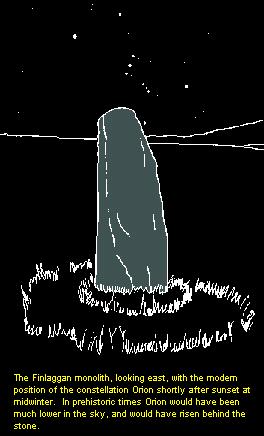
Finlaggan standing stone, Islay
Stones
of Wonder
QUICK LINKS ...
HOME PAGE
INTRODUCTION
WATCHING
THE SUN, MOON AND STARS
THE
MONUMENTS
THE
PEOPLE AND THE SKY
BACKGROUND
ARCHAEOASTRONOMY
USING
THE SITE DESCRIPTION PAGES
VISITING
THE SITES
THE
LEY LINE MYSTERY
THE
SITES
ARGYLL
AND ARRAN
MID
AND SOUTH SCOTLAND
NORTH
AND NORTH-EAST SCOTLAND
WESTERN
ISLES AND MULL
Data
DATES
OF EQUINOXES AND SOLSTICES, 1997 to 2030 AD
DATES
OF MIDSUMMER AND MIDWINTER FULL MOONS, 1997 to 2030 AD
POSTSCRIPT
Individual
Site References
Bibliography
Links
to other relevant pages
Contact
me at : rpollock456@gmail.com
Standing Stone NR393685*
How to find : Three kilometres south-west of Port Askaig is the turn off to the west for Finlaggan (watch for the sign). Follow the road and track for just over 1km. The standing stone is by the roadside. The stone is beside the Finlaggan interpretive centre, which has displays about the excavations on the island in Loch Finlaggan, seat of the Lords of the Isles.
Best time of year to visit : At midwinter the constellation Orion rises over the stone. The sun rises behind the stone about 25th February and again around 18th October.
This fine stone, two metres tall, overlooks Loch Finlaggan, where excavations on the island have been uncovering evidence of occupation in the time of the Lords of the Isles. A visitor centre is open in the summer months. The standing stone is assumed to date to a much earlier era than the island site.

The stone has two wide faces, one of which is flattened, and these are twice as thick as the other sides; this suggests we should look along the flatter sides to the east and to the west. The horizons are featureless in both directions, and to be honest no clear point on the horizons could be indicated unambiguously by a standing stone of this shape.
To the higher horizon to the west, the azimuth indicated is in the range of about 284° to 292°, which with a horizon height of over 4° gives declinations of no known significance.
In the other direction, to the east, the approximate azimuth range of 104° to 111° with a horizon height of 1° give declinations of between -11.3° and -7.3°.
Alexander Thom suggested that the builders of the standing stones and stone circles created and used a solar calendar[1], consisting of 16 'months'. The passing of the months would have been recorded by the sun's position on the horizon, with the key points being the two solstices; the two equinoxes; the four Quarter days, midway between the solstices an equinoxes; and finally the eight points intermediate between all the forementioned. Apart from the summer and winter solstice positions, a marker would catch the sun moving on the horizon twice in each year.
The range of values given for the declinations indicated by the Finlaggan stone to the east cover one of the eight intermediate dates, and the stone indicates generally the position of the rising sun at the end of February and again in the middle of October. Many writers have observed that Neolithic subsistence farmers would seem to have little use for such an intricate calendar.
Another possible interpretation of the orientation of the stone is that it actually marked the winter rising position of the constellation Orion.
This is today as in prehistoric times the most distinctive of all the star patterns, and the only one which has something like a human form. Due to the precession of the equinoxes, Orion in the Neolithic and Bronze Age periods was much lower in the sky and would have risen, from an observer's point of view, behind the stone, the bright stars Betelgeuse and Bellatrix shining into sight first. Nowadays the whole constellation is in sight directly above the stone early on a midwinter's evening.